[Update: This will be a regular feature in V2.2, not an “advanced” feature]
Double (or multiple) star systems are not static. The primary and secondary stars typically move with respect to each other. These relative movements can be extremely small (i.e. they don’t appear to move over a period of decades or longer), or they might move relatively rapidly (with noticeable relative motion over a period of months or years). The double star catalogues, and in particular the Washington Double Star (WDS) catalogue, typically only show a single instance or snapshot of relative position (separation and position angle) for each object, which might be quite out-of-date (some even 100+ years out of date).
Many such star systems have been observed and the relative positions of the stars noted over an extended period, allowing the actual orbits of the stars to be estimated. A new feature in the Advanced version of AstroPlanner allows you to see those orbits and estimate the current relative positions of the stars.
The US Naval Observatory, which maintains the WDS, also maintains a database of orbital elements for a (relatively small) subset of the double stars in the WDS. There are currently 2,400+ orbits in the database. The AstroPlanner WDS catalogues have been (or will be) modified to include these data where applicable. Here’s how you can use this information.
When you open a double-star catalogue (initially, at least, it will only be the WDS catalogues), any double star entry that has associated orbit information will be shown with the Separation and Position Angle column entries in orange:

Here, two objects have orbits (orange text in the Sep and Angle columns). To see information about the orbits, select the desired object and right-click. Choose then Show Orbit/s… menu entry:
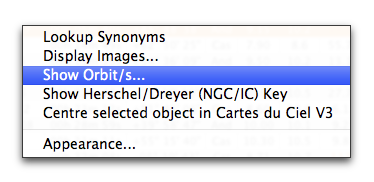
A window is displayed with the known orbital info for that star system:
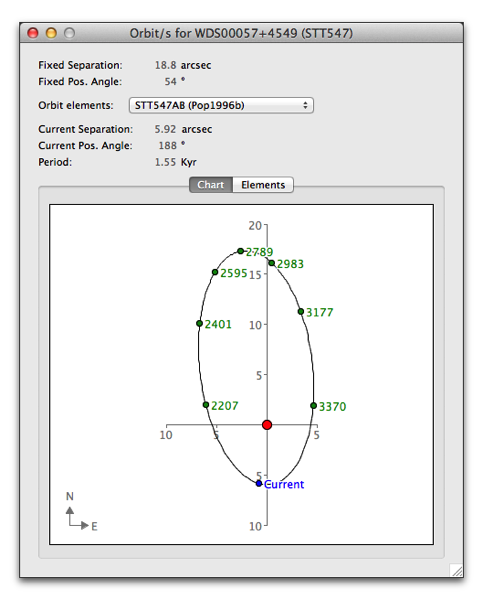
The orbit is plotted on axes (scaled in arcseconds from the primary – the red blob). The current position of the secondary is shown in blue, and some future positions are shown in green, with the year. The information above the chart shows that this orbit has an estimated period of 1550 years, and that based on the orbit, the current separation and position angle are 5.9 arcsec and 188° respectively. The Orbit elements popup tells you that the chart is for the AB components, and the reference is given in parentheses. The fixed separation/position angle refers to the fixed values in the catalogue entry (which as mentioned before might be quite old, and possibly inaccurate).
The Elements tab shows the actual numbers, if you are interested:
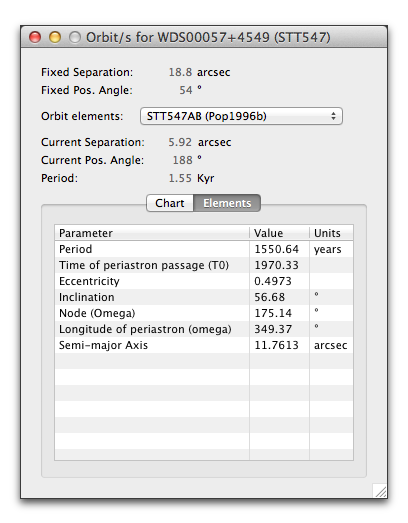
There might be more than one orbit for the system. In this case there’s another AB orbit:
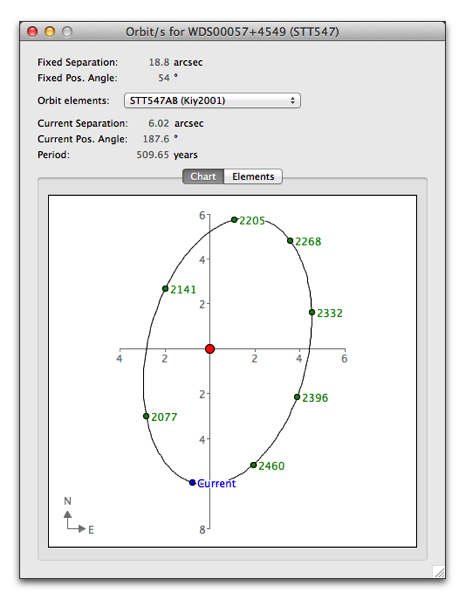
Note that this (2001) orbit is significantly different from the other (1996) orbit, although the current position is pretty much identical. Such is the world of insufficient information. As the years go by, the estimated orbital elements will undoubtedly get better. Long after AstroPlanner and yours truly are archeological relics, many of these long-period orbits might be quite accurate.
The same applies to the object list and the results window (the columns are shown in orange, and there’s a right-click Show Orbit/s item). However, in the case of the object list there’s also a Set Object button. Clicking it will replace the “fixed” separation/position angle values for the object with the computed current values, and the Period with the computed period.
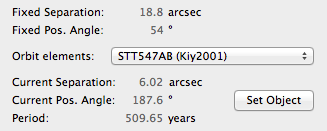
As usual, note that this feature might change between now and release. Or never get released at all for that matter.